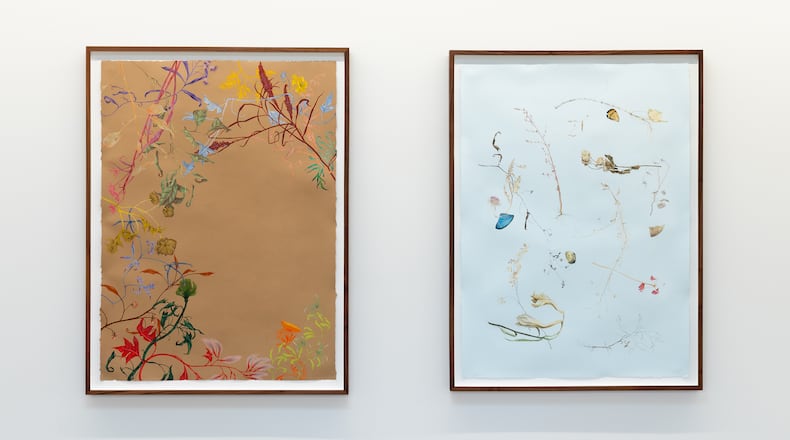It’s not often that a contemporary artist offers a book of poetry alongside a gallery show.
But Zachari Logan isn’t your usual artist with his idiosyncratic style that blends a Lars von Trier-level sense of doom and the romanticism of the British poets Keats, Shelley and Byron. This is an artist, after all, who offers an ode to a cypress tree that the German writer Johann Wolfgang von Goethe once sat beneath in “Goethe Cypress, Sunset; Guisti Gardens.” In his poetry book “A Natural History of Unnatural Things” he describes looking at art as “a dialogue with ghosts” as simple and as true a distillation of the magic of creation that spans centuries as any. As with so many of his drawings, the tree is captured in an unusual composition that changes mere rendition to subjective vision. The tree is represented by a portion of its boughs leaning into the frame, as the tree might be experienced lying beneath it and looking up. The cypress is framed against Logan’s soft blue paper that stands in for sky.
Credit: Handout
Credit: Handout
In “The Blooming Skin” at Wolfgang Gallery Logan offers up a worldview steeped in the laws and rhythms of the natural world.
Though it feels distinctly contemporary with its emphasis on a human body and nature in flux, Logan’s work just as often feels rooted in ecstatic, mystic visions of nature with links to the Romantics. In his exquisitely detailed, hyperrealistic drawings of meadows and skeletons, blossoms and trees, Logan offers up odes to nature as a complex, wondrous organism and one that we return to inevitably.
Based in Saskatchewan, Canada’s “sunniest” prairie province, an origin story that only adds to his mystique, Logan creates death- and-decay-fixated drawings that conjoin morbidity and loveliness. In his shape-shifting drawings thistle, dandelions, lilies and clematis intertwine, growing in wild, tangled clumps, disparate cultivars welded together in the artist’s verdant imagination.
But also growing amidst that botanical fray are mouths sprouting from a morning glory, and an eyeball at the center of a flower. A human hand appears dead center in “Autoportrait No. 1, (Wildflowers).” In Logan’s fantastic mutations the human, animal and botanical metamorphose, conveying an idea of growth, death and regeneration that binds them together.
In “Summer Bones No. 2″ the artist sketches an array of desiccated plants in various states of decay, petals shrunken and flowers turned brown and brittle. The result is a blend of botanical realism and a despondent mood piece about season’s end. The flowers are set against a pale blue background as contrast to their browning, drying husks, like specimens pressed between the pages of a book to remember the summer bounty.
Credit: Handout
Credit: Handout
The lyricism of works like “Summer Bones” brushes up against the mildly freakish “Invasion of the Body Snatchers” surreality of “Chrysantha,” from Logan’s Wildflower series. In that work, a spooky little number in blue pencil on mylar, the artist’s head sprouts from flower buds, his long hair and beard and mustache giving the image its Metallica-meets-tattoo edge. I found Logan’s work most compelling when it hones in and focuses on minute and quicksilver moments like these. In more complex, multimedia larger works a sense of painterly drama can overshadow Logan’s delicate touch.
Credit: Handout
Credit: Handout
Logan often uses red or blue pencil to sketch on mylar, a process of evanescent marks on a delicate surface that underscores the fragile, fleeting nature of life that constitutes his vision. His work in red pencil “Beetle Becomes Wildflowers” looks like Mother Nature’s family crest, its proud bug at the summit of the drawing, spewing out a cloud of petals and leaves in its wake like flames from a hot rod. Depending upon your bent, Logan’s work can feel soothing and metaphysical or despairing and foreboding but it’s unlikely impossible not to feel something.
ART REVIEW
“Zachari Logan: The Blooming Skin”
Through April 22. 10 a.m.-5 p.m. Tuesdays-Saturdays; free. Wolfgang Gallery, 1240 Old Chattahoochee Ave. NW, Suite H, Atlanta. 404-549-3297, wolfganggallery.com.
Bottom line: A poetic vision of life’s beauty and fragility as seen through the eyes of a Canadian artist steeped in visions both dark and romantic.
About the Author
Keep Reading
The Latest
Featured





